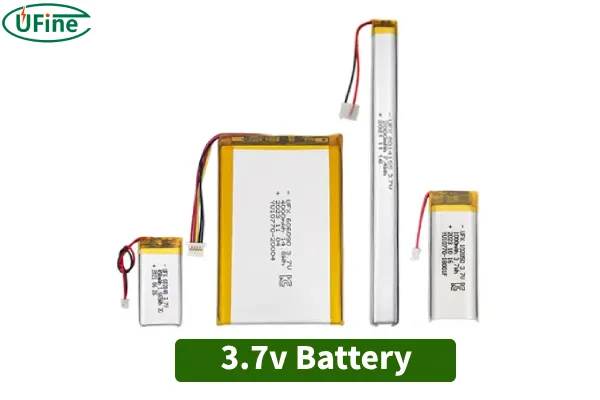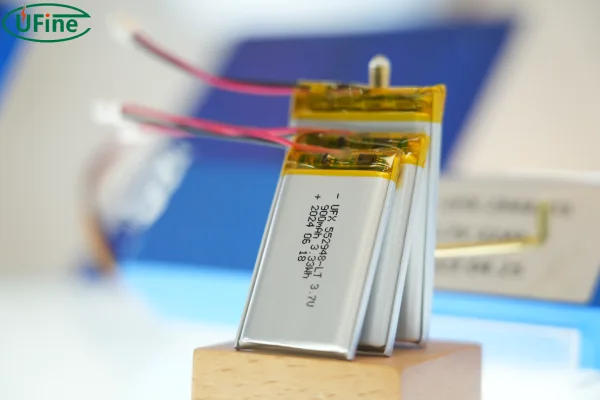3.7V batteries are an integral part of our daily lives, powering a wide range of electronic devices, from smartphones to drones. Despite their ubiquity, many people are unaware of what makes these batteries tick. In this comprehensive guide, we’ll delve into the world of 3.7V batteries, explaining everything from their basic characteristics to their various applications. Whether you’re a tech enthusiast or just a curious consumer, this guide will provide you with valuable insights into the versatile 3.7V battery.

Part 1. What is a 3.7V battery?
A 3.7V battery is a type of lithium-ion battery that operates with a nominal voltage of 3.7 volts. This nominal voltage is an average value that the battery maintains through most of its discharge cycle. These batteries are known for their high energy density, which means they can store a significant amount of energy in a relatively small and lightweight package. This makes them ideal for use in portable electronic devices.
- High Energy Density: Stores more energy per unit weight compared to other battery types.
- Lightweight: Perfect for gadgets where weight is a critical factor.
- Long Lifespan: Can be recharged many times before performance degrades significantly.
Part 2. Why is it 3.7V?
The 3.7V rating is derived from the chemistry of lithium-ion cells. These batteries typically operate within a voltage range of 3.0V (when nearly discharged) to 4.2V (when fully charged). The nominal voltage of 3.7V represents an average operating voltage over the discharge cycle.
- Optimal Performance: Balances energy density and safety.
- Efficient Power Delivery: Provides sufficient power for most portable devices without excessive heat generation.
- Standardization: Many devices are designed to operate around this voltage, making 3.7V batteries a versatile choice.
Part 3. 3.7V battery types
There are several types of 3.7V batteries available, each with its own unique properties and use cases:
- Lithium-Ion (Li-ion): The most common type, known for its high energy density and long cycle life. Used in smartphones, laptops, and many other portable devices.
- Lithium-Polymer (Li-Po): Offers a flexible form factor, making it ideal for slim and lightweight devices like tablets and drones. Li-Po batteries can also be more stable and safer.
- Lithium-Iron Phosphate (LiFePO4): Known for safety and thermal stability, these batteries are used in applications requiring a high level of safety, such as electric vehicles and power tools.
- Lithium-Manganese Dioxide (LiMnO2): Often used in high-drain devices because of their ability to deliver high current.
Part 4. 10 Key specifications of 3.7V li-ion battery
3.7v li ion battery is a common 3.7V battery, we will introduce it in detail.
-
Nominal Voltage:
- 3.7V (This is the average voltage during discharge)
-
Fully Charged Voltage:
- 4.2V (Maximum voltage when fully charged)
-
Discharge Cut-off Voltage:
- 3.0V (Minimum safe discharge voltage to prevent damage)
-
Capacity:
- Typically ranges from 500mAh to 3500mAh depending on the battery model and application.
-
Charge Current:
- Usually rated at 0.5C to 1C, where C is the battery’s capacity (e.g., 1C for a 1000mAh battery would be 1000mA). Fast charging is typically limited to 1C.
-
Discharge Current:
- Typical continuous discharge rate is 0.5C to 2C, but high-discharge models can go higher (up to 5C for specific applications like power tools).
-
Energy Density:
- Ranges from 150 Wh/kg to 250 Wh/kg, depending on the specific battery model, affecting its overall energy storage capacity.
-
Cycle Life:
- 300 to 500 cycles at 80% depth of discharge (DoD) before the capacity drops to about 80% of its original capacity.
-
Weight:
- Typically 30g to 50g for a single cell, depending on capacity and form factor.
-
Operating Temperature:
- Typically operates within a range of -20°C to +60°C for charging, and -20°C to +60°C for discharging, with optimal performance at room temperature.
These specifications can vary based on battery design, manufacturer, and intended use, but these are the key features to consider when evaluating or using a 3.7V Li-ion battery.
Part 5. Charging and discharging of 3.7V li-ion battery
Charging:
- Charging Voltage: A 3.7V Li-ion battery is charged to a maximum of 4.2V.
- Charging Stages:
- Constant Current (CC): Initially, the battery is charged at a constant current (usually 0.5C to 1C) until it reaches 4.2V.
- Constant Voltage (CV): Once 4.2V is reached, the voltage is maintained at this level, and the current gradually decreases until it drops to a minimal level, indicating a full charge.
- Safety: Use a proper Li-ion charger with overcharge protection to avoid overcharging or overheating.
Discharging:
- Discharge Voltage: The battery should not be discharged below 3.0V to avoid damage.
- Discharge Characteristics:
- The voltage decreases gradually with use. Below 3.0V, the battery can become unstable and lose capacity.
- A Battery Management System (BMS) is typically used to monitor and prevent over-discharge.
How to Charge:
- Use the correct charger: Always use a charger designed for 3.7V Li-ion batteries (with overcharge protection).
- Charge in a safe environment: Avoid charging in extreme temperatures or near flammable materials.
- Monitor the process: Ensure the charging stops at 4.2V to protect the battery from overcharging.
Note: A proper charger with overcharge and over-discharge protection ensures safety and battery lifespan.
How to Read Lithium Battery Discharge Curve and Charging Curve?
Part 6. Which 3.7V battery should I buy?
Choosing the right 3.7V battery depends on your specific needs and the device it will power. Here are some considerations:
- For Smartphones and Tablets: Li-Po batteries are often preferred due to their slim form factor and lightweight nature.
- For Laptops: Li-ion batteries are a good choice because they offer high capacity and a long lifespan.
- For Drones and RC Models: Li-Po batteries are ideal as they provide high power output and are lightweight, allowing for longer flight times.
- For Power Tools: LiMnO2 or LiFePO4 batteries are suitable due to their ability to deliver high current and ensure safety.
Part 7. How long does a 3.7V battery last?
The lifespan of a 3.7V battery can vary based on several factors, including usage patterns, charging practices, and the quality of the battery itself. Generally, a well-maintained 3.7V battery can last between 300 to 500 charge cycles. For most users, a 3.7V battery in a smartphone or similar device will last about 2 to 3 years under normal usage conditions before its capacity noticeably diminishes.
Here’s a closer look at the factors that influence battery longevity:
Factors Affecting Battery Life:
- Usage Patterns: Frequent and intense use can shorten the battery life. Devices that draw a high current will deplete the battery faster.
- Charging Practices: Proper charging habits, such as avoiding overcharging and deep discharging, can significantly extend the battery’s lifespan.
- Storage Conditions: Storing batteries in a cool, dry place and at around 50% charge can help maintain their health over time.
- Battery Quality: Higher quality batteries from reputable manufacturers typically last longer and perform better.
Part 8. 3.7V battery capacity
Battery capacity is measured in milliampere-hours (mAh) and indicates how much charge a battery can hold.
Here are some common capacities for 3.7V batteries and their typical applications:
- 500mAh-1000mAh: Suitable for small devices like Bluetooth earphones, fitness trackers, and small remote controls.
- 1000mAh-3000mAh: Commonly used in smartphones, handheld gaming consoles, and compact cameras. These capacities provide a good balance between size and performance.
- 3000mAh-5000mAh: Ideal for tablets, portable speakers, and larger handheld devices that require more power for extended use.
- 5000mAh+: Used in laptops, drones, and other high-power devices where long battery life is essential.
Part 9. 3.7V battery charger
Charging your 3.7V battery correctly is crucial for maintaining its health and extending its lifespan. There are various types of chargers available, each suited to different needs:
Types of Chargers:
- Standard Chargers: These provide a steady charge rate and are suitable for most applications. They are simple and reliable.
- Fast Chargers: Designed to charge batteries quickly by delivering a higher current. While convenient, they can generate more heat, which may reduce battery life if used frequently.
- Smart Chargers: These are equipped with features like automatic shutoff, trickle charging, and temperature monitoring. These chargers help protect the battery from overcharging and overheating.
Charging Precautions:
- Avoid Overcharging: Disconnect the charger once the battery is fully charged to prevent overcharging, which can degrade the battery over time.
- Use the Right Charger: Always use a charger that is compatible with your battery’s specifications. Using an incorrect charger can lead to damage or even pose safety risks.
- Charge in a Cool Environment: Charging in a cool, ventilated area helps prevent the battery from overheating.
Part 10. 3.7V battery applications
3.7V batteries are incredibly versatile and power a wide array of devices. Here are some common applications:
1.Consumer Electronics:
- Smartphones and Tablets: Powering the devices we use daily for communication, entertainment, and productivity.
- Laptops: Providing the necessary energy for portable computing.
- Wearables: These are used in smartwatches, fitness trackers, and other wearable tech due to their compact size and lightweight nature.
2. Hobby and Leisure:
- Drones: Offering the high power needed for flight and onboard systems.
- Remote Control (RC) Models: Used in cars, boats, and planes for their ability to deliver high currents.
3. Industrial and Medical:
- Power Tools: Provide the muscle for drills, saws, and other power tools, especially those using LiMnO2 or LiFePO4 batteries.
- Medical Devices: Ensuring reliability and safety in devices such as portable oxygen concentrators and infusion pumps.
4. Renewable Energy:
Solar Power Storage: Used in small-scale solar setups to store energy for later use.
In this comprehensive guide, we’ve explored the world of 3.7V batteries, from their fundamental characteristics to their diverse applications. Whether you’re looking to power a smartphone, a drone, or a medical device, understanding the nuances of 3.7V batteries will help you make informed decisions and get the most out of your devices.
Related Tags:
More Articles

How to Choose the Best Floor Scrubber Battery for Commercial Cleaning?
Selecting the ideal floor scrubber battery ensures a long runtime, rapid charging, and minimal maintenance for efficient commercial cleaning operations.
Battery for Blower vs Battery for Leaf Vacuum: Which One Should You Choose?
Battery for blower vs leaf vacuum—learn the key differences in power, fit, and runtime to choose the right battery for your outdoor tool needs.
How to Choose the Right Battery for Blower?
Choosing the right blower battery? Consider voltage, capacity, chemistry & usage. This guide helps match the best battery for peak performance.
How to Choose the Best Insulated Battery Box for Lithium Batteries?
Choosing the Best Insulated Battery Box for Lithium Batteries? Discover key factors such as size, material, and safety for optimal protection and performance.
7 Critical Elements on a Lithium Battery Shipping Label
What must be on a lithium battery shipping label? Learn 7 key elements to ensure safety, legal compliance, and correct handling across all transport modes.




